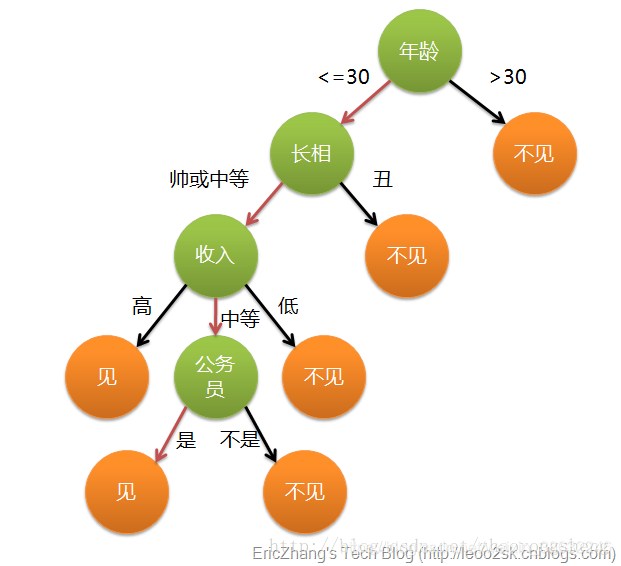
1.决策树的构造:
优点: 计算复杂度不高,输出结果易于理解,对中间值的缺失不敏感,可以处理不相关特征数据。
缺点:可能产生过度匹配问题
适合数据类型: 数值型和标称型
2.决策树创建核心算法:
创建决策树的createTrees()函数
1.检测数据集每个子项是否属于同一类:
if so : return 类标签
else:
寻找划分数据集的最好特征
划分数据集
创建分支点
for 每个划分的子集
调用createTrees()函数并增加返回结果到分支节点中
return 分支节点
3.信息增益
信息增益用于表示数据集划分前后信息发生的变化。
熵的定义为信息的期望值,所用类别可能包含的信息期望值:
熵越高,数据很合越多。
# 决策树算法
import math
#小的数据集
def createDataSet():
dataSet = [[1, 1, 'yes'],
[1, 1, 'yes'],
[1, 0, 'no'],
[0, 1, 'no'],
[0, 1, 'no']]
featureNames = ['no surfacing','flippers'] #不浮出水面是否存活 ,有无脚蹼
#change to discrete values
return dataSet, featureNames
#计算信息熵,因为我们会利用最大信息增益的方法划分数据集-----看哪个特征划分使得,信息熵(数据无序度)减小的最多
def Entropy(dataSet):
num = len(dataSet)
labelCounts = {}
for featVec in dataSet: # 统计每个类别的数量
currentLabel = featVec[-1] #最后1列为键
if currentLabel not in labelCounts.keys():
labelCounts[currentLabel] = 0 #初始值=0
labelCounts[currentLabel] += 1 #统计+1
entropy = 0.0
for key in labelCounts: #
prob = float(labelCounts[key])/num
entropy -= prob * math.log(prob,2) #log base 2
return entropy
#测试一下
myDat,myFeatureNames = createDataSet()
print "the old dataset:\n",myDat
myEntropy = Entropy(myDat)
print "my test entropy should be 0.97095 :\n",myEntropy
#添加一类,mabey,yes,no ====熵越高,表明数据越混乱
myDat[0][-1] = "mabey"
print "the new dataset:\n",myDat
myEntropy = Entropy(myDat)
print "my test entropy should be 1.37095 :\n",myEntropy
#
#the old dataset:
#[[1, 1, 'yes'], [1, 1, 'yes'], [1, 0, 'no'], [0, 1, 'no'], [0, 1, 'no']]
#my test entropy should be 0.97095 :
#0.970950594455
#the new dataset:
#[[1, 1, 'mabey'], [1, 1, 'yes'], [1, 0, 'no'], [0, 1, 'no'], [0, 1, 'no']]
#my test entropy should be 1.37095 :
#1.37095059445
#根据数据集合,创建一个完整的决策树
#划分数据集
#按照给定的特征axis,根据他的取值value,划分数据集,返回新的数据集合,少了1个特征(划分依据的那个特征axis)
def splitDataSet(dataSet, axis, value):
returnDataSet = []
for dataVec in dataSet:
if dataVec[axis] == value:
tempVec = dataVec[:axis] #0--(axis-1)
tempVec.extend(dataVec[axis+1:]) #(axis+1)--(-1) #所以减去了axis
returnDataSet.append(tempVec)
return returnDataSet
#测试一下
myDat,myFeatureNames = createDataSet()
print splitDataSet(myDat,0,1) #axis = 0,且这个特征的值=1
#[[1, 'yes'], [1, 'yes'], [0, 'no']]
#看哪个特征划分使得,信息熵(数据无序度)减小的最多
def chooseBestFeatureToSplit(dataSet):
numFeatures = len(dataSet[0]) - 1 #最后1列是类别
baseEntropy = Entropy(dataSet) #首先计算原始的信息熵
bestInfoGain = 0.0; bestFeature = -1
for i in range(numFeatures): #迭代所有的特征
#将数据集中的第i个特征的值,放到一个list中
featureList = [example[i] for example in dataSet]
uniqueVal = set(featureList) #用set去重
newEntropy = 0.0
for value in uniqueVal:
subDataSet = splitDataSet(dataSet, i, value)#对第i个特征,针对某个值划分
prob = len(subDataSet)/float(len(dataSet))
newEntropy += prob * Entropy(subDataSet) #累加信息熵
infoGain = baseEntropy - newEntropy #计算这次划分的信息增益
if (infoGain > bestInfoGain):
bestInfoGain = infoGain #替换好的值
bestFeature = i
return bestFeature #return 最好的划分特征下标i
#测试
myDat,labels=createDataSet()
index = chooseBestFeatureToSplit(myDat)
print "best feature shoule be 0\n",index
#best feature shoule be 0
import operator
#对字典排序,取得最大值:将多数的类别标签作为“叶子节点”的类别
def majorityCnt(classList):
classCount={}
for vote in classList:
if vote not in classCount.keys():
classCount[vote] = 0
classCount[vote] += 1
sortedClassCount = sorted(classCount.iteritems(), key=operator.itemgetter(1), reverse=True)
#sorted(classCount.items(), key=lambda x:x[1], reverse=True) #对字典排序
return sortedClassCount[0][0] #返回多数的那个类别
def createTree(dataSet,featureNames):
classList = [example[-1] for example in dataSet]
if classList.count(classList[0]) == len(classList): #如果所有的类都一样,第0类的个数==长度
return classList[0]#stop splitting when all of the classes are equal
if len(dataSet[0]) == 1: #stop splitting when there are no more features in dataSet
return majorityCnt(classList) #如果所有的特征都被遍历用于划分数据
bestFeature = chooseBestFeatureToSplit(dataSet)
bestFeatureName = featureNames[bestFeature]
myTree = {bestFeatureName:{}} #用字典存储树结构
del(featureNames[bestFeature]) #从特征名称列表中删除这个bestFeatureName
featureValues = [example[bestFeature] for example in dataSet] #遍历最好的特征的取值,进行划分
uniqueVals = set(featureValues)
for value in uniqueVals:
subNames = featureNames #copy all of featureName, 为了保留原有的featureName不被函数修改
myTree[bestFeatureName][value] = \
createTree(splitDataSet(dataSet, bestFeature, value),subNames) #返回的是一个字典
return myTree
#测试一下
myDat,myFeatureNames = createDataSet()
myTree = createTree(myDat,myFeatureNames)
print myTree
print myFeatureNames #最后的list,会被改变(!!!因为函数参数是list,参数是按照引用的方式传递的)
#{'no surfacing': {0: 'no', 1: {'flippers': {0: 'no', 1: 'yes'}}}}
[]
#测试算法:对于某个输入变量x,使用决策树,进行分类
def classify(inputTree,featureNames,testVec):
firstKey = inputTree.keys()[0] #第一个key,根节点,k=某个特征a的名称
secondDict = inputTree[firstKey] #第二个字典,key是特征a的所有取值
featureIndex = featureNames.index(firstKey)
key = testVec[featureIndex]
valueOfFeature = secondDict[key] #获得叶子节点的值,要么是“类别标签”,要么是key=某个特征b的“字典”
if isinstance(valueOfFeature, dict): #判断实例是否是类型(tuple,dict,int,float)
classLabel = classify(valueOfFeature, featureNames, testVec) #是字典,继续递归
else: classLabel = valueOfFeature #是类别标签,直接返回
return classLabel
myDat,myFeatureNames = createDataSet()
#因为myFeatureNames在函数中,改变了,所以重新加载
class0 = classify(myTree,myFeatureNames,[1 ,0])
print "[1,0] should be classify as 'no'\n",class0
class1 = classify(myTree,myFeatureNames,[1,1])
print "[1,1] should be classify as 'yes'\n",class1